Publications
AI-powered smartphones and phygital tourism experiences: implications and future research directions
Authors: Uglješa Stankov, Ulrike Gretzel, Miroslav D. Vujičić
Abstract
The integration of artificial intelligence (AI) into smartphones represents a transformative shift in mobile technology, enabling smartphones to seamlessly blend physical and digital realms and thereby enhance phygital tourism experiences. This viewpoint explores the implications of AI-powered smartphones for phygital tourism experiences by focusing on new ways of interaction with smart tourism destinations based on pervasiveness, agile integrations, and capabilities for hyper-customization. It also presents the potential impacts of these interactions, including the supporting, enhancing, and transforming impacts of AI-powered smartphones in phygital tourism experiences. In addition, it explores new research directions, such as perceptions of and interactions with smart destinations, deeper integration with extended reality technologies, the humanizing aspects of AI, well-being effects, and the ethical considerations of responsible AI. The article is conceptual, synthesizing insights from smart tourism, artificial intelligence, phygital marketing, and related fields. A primary goal is to identify new avenues for enhancing phygital tourism experiences and to provide some insights into AI in this evolving field.
Transformer based super-resolution downscaling for regional reanalysis: Full domain vs tiling approaches
Authors: Antonio Pérez, Mario Santa Cruz, Daniel San Martín, José Manuel Gutiérrez
Abstract
Super-resolution (SR) is a promising cost-effective downscaling methodology for producing high-resolution climate information from coarser counterparts. A particular application is downscaling regional reanalysis outputs (predictand) from the driving global counterparts (predictor). This study conducts an intercomparison of various SR downscaling methods focusing on temperature and using the CERRA reanalysis (5.5 km resolution, produced with a regional atmospheric model driven by ERA5) as example. The method proposed in this work is the Swin transformer and two alternative methods are used as benchmark (fully convolutional U-Net and convolutional and dense DeepESD) as well as the simple bicubic interpolation. We compare two approaches, the standard one using the full domain as input and a more scalable tiling approach, dividing the full domain into tiles that are used as input. The methods are trained to downscale CERRA surface temperature, based on temperature information from the driving ERA5; in addition, the tiling approach includes static orographic information. We show that the tiling approach, which requires spatial transferability, comes at the cost of a lower performance (although it outperforms some full-domain benchmarks), but provides an efficient scalable solution that allows SR reduction on a pan-European scale and is valuable for real-time applications.


